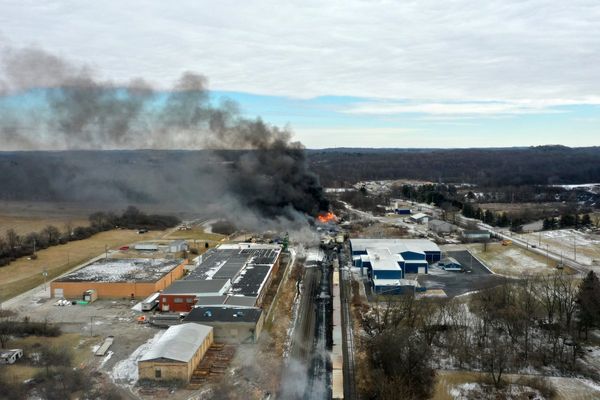An inquest has heard that a fire alarm system had been silenced at a hospital in Dublin at a time a patient suffered fatal burns after a cigarette was lit near an oxygen cylinder in his ward.
A sitting of Dublin District Coroner’s Court heard Joseph Murphy, 85, sustained extensive burn injuries to his body in the early hours of Christmas Eve in 2018 after his bed in St Luke’s Hospital in Rathgar went up in flames.
Mr Murphy, a widower and father of six from Walkinstown, was transferred to St James’s Hospital in Dublin but died later the same day.
Read More : Hero soldier Sean Rooney to be laid to rest with full military honours
Until the accident, he had been recovering well from treatment in hospital and had been transferred to St Luke’s as a step-down facility while he was awaiting for a homecare package to be put in place to allow him return home.
The inquest had previously been adjourned by the coroner, Cróna Gallagher, in order to establish more information about the fire alarm system in place in St Luke’s at the time.
The hospital’s chief operations officer, Jennifer Carey, admitted to the hearing on Monday, that the alarm system in place at the time of Mr Murphy’s death four years ago could have been muted anywhere within the hospital and not just in the area of his ward.
Ms Carey said the issue had subsequently been corrected and only a few staff could now mute or silence the alarm system.
She said testing of the new system was now done on a weekly basis so staff would be familiar with the sound of smoke alarms while there had also been updated training provided for all hospital workers on the use of the fire alarm system.
In response to questions from Dr Gallagher, Ms Carey said St Luke’s had extensively investigated the issue of the smoke alarm system being silenced at the time of Mr Murphy’s death but no staff member could recall having changed the warning settings.
She acknowledged it was possible for the alarms to be silenced from anywhere in the hospital at the time.
Ms Carey said it was difficult to say why that would have been considered a good idea but she said there was no evidence that St Luke’s had sought for that to be part of the system.
The official said there were also signs in place to warn patients, visitors and staff about the danger of smoking particularly in the vicinity of oxygen.
Dr Gallagher noted that there had been no prior warning signs that Mr Murphy was trying to smoke during his stay in St Luke’s.
A project manager with Masterfire Life Safety Systems, Caolán Devlin, said the company had taken over responsibility for the fire alarm system in St Luke’s since 2019.
Mr Devlin said the hospital now had a pre-alarm warning that would alert staff when there was a small level of smoke before the full alarm was activated.
He estimated there are around 1,500 alarms fitted around the hospital’s buildings.
Evidence was heard earlier this year from several hospital staff who said they heard a low beep around the time of the incident but were uncertain what it signalled.
One nurse said she thought it might have indicated a low battery level on some piece of equipment.
A healthcare assistant who was on duty, Gerard Smith, said Mr Murphy had rung his call bell to ask for tea and biscuits at around 4.55am.
Mr Smith said he had left the patient sitting up by the side of the bed.
While he heard a beeping sound, he did not realise there was any possible fire until he heard screams for Mr Murphy and he returned to find the patient’s ward full of flames and smoke.
Garda and Dublin Fire Brigade witnesses informed the coroner that a packet of cigarettes and a cigarette lighter were found at the scene where there had also been an oxygen cylinder that had been prescribed for Mr Murphy.
Dr Claragh Healy, a consultant plastic surgeon at St James’s Hospital, said Mr Murphy had suffered severe burns to 49% of his body with the worst affected areas being his limbs, buttocks, lower chest area and abdomen.
Dr Healy said it was highly unlikely that the patient could have survived the injuries given his other medical conditions.
A post-mortem showed he died from extensive burns injuries with diseases of the heart and lungs as well as diabetes regarded as contributory factors.
Returning a verdict of accidental death, Dr Gallagher said certain facts about the fatal incident had not been possible to establish.
Although relatives of Mr Murphy claimed there was no evidence of a lit cigarette in their father’s ward, the coroner said that she believed a cigarette being lit was the cause of the fire “on the balance of probabilities” given the evidence about cigarettes and lighter by his bedside.
Dr Gallagher said she endorsed the changes made to the fire alarm system and fire safety training at St Luke’s after the fatal incident as they had addressed concerns she had about the case.
READ NEXT:
- Ireland Christmas weather ‘roller-coaster’ amid new ‘Beast from the East’ threat
- JP McManus on his racing empire, gambling and taking every day as it comes
- Ryanair tells passengers 'find your own way home' after 480km diversion due to snow
- Irish farmers can bid for date with stunning blonde at cattle mart auction
- Operation Transformation star quits show as RTE announce replacement for new season return
Get breaking news to your inbox by signing up to our newsletter







